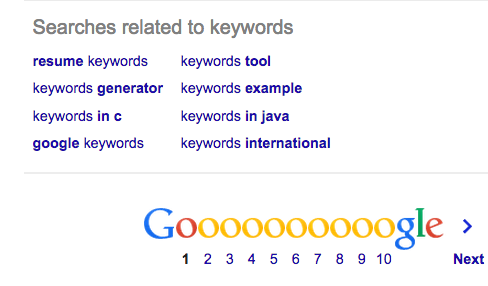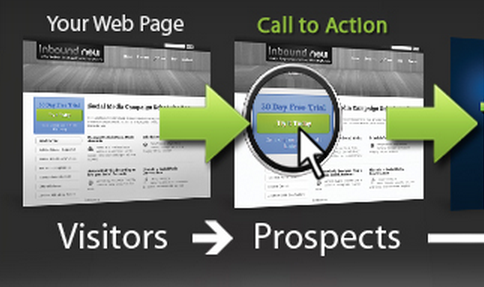Writing a high-quality business blog post on a regular basis can quickly become drudgery if you don’t do it right.
Fortunately, like any professional pursuit, patterns for blogging success have emerged and conventions have been developed. The art of blogging is no longer a guessing game and if you stick to proven formulas, you’re more likely to be successful at creating content that attracts readers.
The purpose of writing business blog is to attract new customers, and the best way to do that is to solve their problems. Readers who like your solutions to their problems are more prone to trust you and possibly hire you or buy something from you.
A quick Internet search reveals that Information is the #1 reason people search the internet. The sharing of information should be your #1 goal, #2 being entertainment.
Drawing from what I’ve learned in seven years of blogging, here’s are the things every perfect business blog post needs to satisfy readers:
Viable Keywords
 Fortunately, the world is full of problems to solve. If your customers are not giving you ideas of what problems you can solve for them, try Googling.
Fortunately, the world is full of problems to solve. If your customers are not giving you ideas of what problems you can solve for them, try Googling.
Use Google to get ideas about what people are saying about your industry and take note of the keywords they use. Once you see a pattern of keywords, use them to dig deeper into a topic of interest.
To get ideas about popular keyword phrases, use the Google autocomplete function. Then, go to the bottom of that Search Results Page and look at the Searches Related to for more ideas.
Once you have them, test your keywords and phrases in Google’s Keyword Planner to see how searched they are.
Current research and the law of averages show that you’ll get more traffic from long-tail keyword phrases than short-tail keywords. Instead of a short-tail keyword like “wine,” which is widely used and faces tremendous competition online, you would do better to use “Superbowl Sunday Wines” to grab a more focused, specific market.
As they say, better to be a big fish in a small pond…
To optimize your posts and pages for your chosen keywords, use WP SEO by Yoast.
You can’t just add a bunch of keywords as meta tags to your post. You must work your keywords or key phrases multiple times into your text as well as in your Headline (title), permalink, post heading, and in your Meta Description.
Optimizing for keywords can be time consuming, but it’s well worth doing if you want your content to be found.
Related: Keywords are Useless – Long Live Keywords!
Interesting topic
 Once you have your keyword or keyword phrase, there are basically two ways to approach the writing of a business blog post topic.
Once you have your keyword or keyword phrase, there are basically two ways to approach the writing of a business blog post topic.
Timely
Your topic might be timed with a news event, holiday, season. That timely event might tie to an audience looking for what you are selling at that period of time.
WordPress releases new major versions every 5-6 months, which provides me with fodder to write timely reviews.
When the minors were rescued in Chile, I wrote reviews of Chilean wines around them.
Christmas is an easy season to write about, but what about Secretary’s Day or International Women’s Day?
Even if your products or services aren’t directly in demand during a timely event, that event can be a stepping off point for a clever metaphor. For instance, “Wines to Drink for the Superbowl.”
Evergreen
If it’s not timely, your topic should be evergreen. That is, information in demand all the time.
How To’s are probably the most evergreen of all content. Write as if a beginner is born everyday and you’re there to explain how to do something as clearly as possible.
Tips are extremely popular as they give people ideas about ways to accomplish things that matter to them.
Reviews are always helpful, but depending on the subject, they could have shelf lives. Nobody in 2015 wants to read a software review from 2010.
For more ideas on business blog post topics, check out Chris Brogan’s top 100 list
Eye-catching headline
 There is a whole school of research that insists that your headline will make or break your blog post.
There is a whole school of research that insists that your headline will make or break your blog post.
It’s true. Headlines must grab reader’s attention with a sexy promise that can’t be ignored. Yet, you have to deliver on that promise or readers won’t trust you.
To create the kind of headlines that strike at the readers brain stem and make them click, Catherine Pascuas came up with this simple headline formula that incorporates the following ingredients:
- A number – preferably random odd numbers like 19, 27, 836
- Or, a trigger word – Why, How, What, When
- Interesting adjectives – Effortless, Painstaking, Fun, Free, Incredible, Essential, Absolute, and Strange
- A unique rational – Reasons, Principles, Facts, Lessons, Ideas, Ways, Secrets
- An audacious promise – a value proposition or a dare
Pascuas cautions us to choose either a number or a trigger word, but not both.
Here’s her formula:
Number or Trigger word + Adjective + Keyword + Promise = Clickable Headline
Here’s my example:
“How to Write Attention Getting Headlines to Get Wickedly High Traffic”
Try it, it works.
Or you can use the Portent Title Maker to help you out.
Related: Studying at the David Ogilvy School of Blog Headlines
Captivating introduction
Like a good book, you must grab your readers in the first sentence and render them unable to look away. Jump right into the action and go from there.
Resist the urge to warm up to the subject, or give a backstory. Use the first paragraph as if you are pitching a story idea to a magazine editor.
Tell the reader right up front what you are about to tell them and how it will benefit them. And, use that keyword phrase in the first sentence to reinforce your topic.
Compelling information
The body of your post is where you’re going to state your points with a fresh perspective.
Put forth your thesis and back it up with facts and resources. Fortunately, being on the Internet, you don’t need to quote entire sources of information; that’s what links are for.
Unless you are writing for an academic audience, your tone should be conversational, as if you were having a chat with a friend or colleague. That’s not to say it should be wordy, just informal.
Be pithy in your sentence structure and clear in your syntax, so your readers don’t have to re-read passages to understand them.
And if you use asides to illustrate a point, keep them succinct to avoid loosing readers.
It’s a good idea to lighten up a business blog post with tasteful humor wherever appropriate, and to insert cultural references when they are relevant to your audience.
The best blog writing informs and entertains. Strive for that.
Related: 5 Big Differences Between Writing and Blogging
Readable formatting
How people read is as important as what they read. The sexiest story in the world can look dull as heck when the type is too small or lines are too long. You want to present your business blog post in as easy to read way as possible.
- Use a font that’s clear and large enough to read without strain.
- Make paragraphs short (1-3 sentences) and sentences short to medium-length.
- Use bullet lists to call out talking points.
- Create listicles of Top 10 Things.
- Be consistent in the use of Caps and Bolds and Italics.
- Use descriptive Header (H2) tags to break up text.
- Never have typos, but if you do, fix them asap.
The length of your post is also related to readability. There is much being said about the value of a long-form post, (2000+ words) on the page and in Google rankings, but is it right for your niche?
Google, and by extension Yoast, require 300 words to warrant search engine attention. That’s about a 2.5 minute read, just short enough for Google to consider it a Bounce. You want to keep your reader longer.
400-500 words is just meaty enough to keep readers engaged. 500-1000 words is good for a How To or Top Ten List. This post, over 2100, is long enough to be a book chapter.
Basically, you just have to experiment to see what appeals to your audience.
Alluring images or videos

Every picture tells a story, don’t it?*
If you fail to add an image or two, your post will look like it’s missing something.
Why? Because readers crave images. Pictures break up the text, illustrate your point, and make the post feel more relatable.
Most WordPress themes call for a Featured Image. That image is like the post’s book cover, following it wherever it goes. If nothing else, include a Featured Image.
Images that are inserted in the WordPress Editor among the text stays on the page itself. Some social media allows you to choose from those images when posting.
Images need to be well placed – flush right, flush left or centered – and sized to harmonize with the text.
If you are photographically creative, you can do a lot with a digital camera and photoshop. Get ideas by Googling images with your keyword and then go out and shoot something original and manipulate it to express your vision.
For the less creative, there are sites that offer the use of free images with credit. There are also sites where you can buy stock images. Some photographers will allow you to use a credited image if you ask nicely. There are also archival images on the internet available for free.
Also, images found on a company website – such as new products – are available for free. Heck, they WANT you to use their images. The same goes for movie stills, record covers, and anything found under a site’s Media tab. All free.
Make sure you size your images to a maximum of 1000 px and 72 dpi before uploading them to WordPress. Once loaded, use a plugin like Smushit for further compress them so they load faster.
Insert your keyword in your image’s title and copy that into the Alt Text, Description, and if you use it, the Caption. You can work harder at optimizing the image using WP SEO by Yoast.
Videos are also popular in business blog posts since they offer action and sound.
For How To’s, videos are indespensible. Shooting with a smart phone camera and editing a file in iMovie or Quicktime is the basic level of production, but can look pretty amazing.
If your business is computer related, you can create screencast video and audio using Quicktime, but more sophisticated options exist – for a price.
Your edited video file must be uploaded to a service like YouTube or Vimeo, since WordPress can not handle a file large enough to play more than 8 seconds of video.
WordPress will now let you paste in the video’s url in the Edit Box and it will format a preview for you. Otherwise, in the case of Youtube, just grab a pre-set embed code and paste in the Text view of the Editor.
Related: Embedding Videos in WordPress is Easy
Audio is easy to place as well. Files can be uploaded to the Media Manager where you can put together a Playlist to insert into the post. This is a cool feature if you also podcast your posts.
Useful links
 Links are the backbone of the Internet and you must include them to make Google love your site.
Links are the backbone of the Internet and you must include them to make Google love your site.
Links create a richer reader experience and will support your argument without you quoting extensive passages. So, add some External links to your sources and Internal links to your pages.
External links
When adding External links be sure they are of good quality and have staying power. And be sure to set them to Open in a New Window so your site does not get left behind.
Internal links
Setting Internal links is easy when using the Search function in the links window. Linking internally is the best way to keep readers on your site by pointing out more related information.
Some sites break up the text with emboldened call out links like this:
Related: Don’t Bite the Hand that Backlinks to You: Use 301 Redirects
The Related Links function of your theme that appears after the post will also keep the attention of readers by steering them toward stories in the same Category.
Irresistable Call-to-Action
 By the end of your business blog post, you must give your readers something to do. Give them a Call to-Action.
By the end of your business blog post, you must give your readers something to do. Give them a Call to-Action.
Your conclusion must reiterate the original point of your post and offer readers a chance to agree, disagree or add a thought in your comments. That’s the most common form of a Call to-Action.
Other a Calls-to-Action are: subscribe to this blog, follow on social media, call now for an estimate, buy an ebook, sign up for seminar, sign a petition, try a service for 14 days, etc.
There are plugins to present Calls-to-Action uniformly and automatically. I use Calls to Action for the page and CTA Widget for sidebars. I also use OptinMonster to get readers to subscribe
Whatever you do, give your readers something to do.
Write that business blog post
With enough practice, and by including all these elements, it won’t be long before you’re able to whip out a business blog post in an hour.
Before you post, read this 13 point blog checklist to make sure you’ve covered everything.
Now, tell me, what have I forgotten?
[related_posts limit=”4″ image=”3″]

